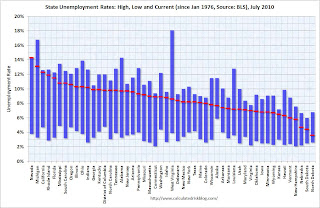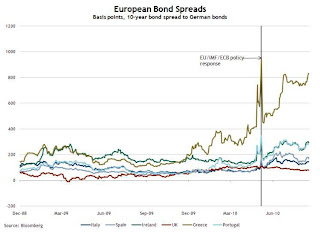by Calculated Risk on 8/20/2010 03:20:00 PM
Friday, August 20, 2010
Huge miss coming on Existing Home Sales?
MarketWatch is reporting the consensus for July existing home sales is 4.85 million SAAR (seasonally adjusted annual rate).
And from Dow Jones: Week Ahead
"July existing-home sales ... likely declined 4.3% from June"June sales were reported as 5.37 million, so a decline of 4.3% would be 5.14 million SAAR.
Note: July existing home sales will be reported next Tuesday.
Housing economist Tom Lawler's preliminary forecast was 3.95 million SAAR (based on a bottom up analysis).
Many of the regional reports showed sales declines of 20% or more from July 2009 when the NAR reported sales of 5.14 million SAAR. A 20% decline from July 2009 would be in the low 4 millions ...
Maybe the MarketWatch and Dow Jones consensus numbers are incorrect (other numbers will be released later today), or there is probably going to be a big miss next Tuesday. Take the WAY under!
Next week will be VERY busy - I'll have more in the weekly preview on Sunday.
HAMP data for July
by Calculated Risk on 8/20/2010 11:43:00 AM
From Treasury: HAMP Servicer Performance Report Through July 2010
And here is the HUD Housing Scorecard.
About 422 thousand modifications are now "permanent" - up from 389 thousand last month - and 617 thousand trial modifications have been cancelled - up sharply from 521 thousand last month.
According to HAMP, there are 255,934 "active trials", down from 364,077 last month. There is still a large number of borrowers in limbo since only 165 thousand trials were started over the last 5 months. I expect another large number of cancellations in August.
Notice that the pace of new trial modifications has slowed sharply from over 150,000 in September to under 17,00 in July. The program is winding down ...
Debt-to-income ratios
If we look at the HAMP program stats (see page 3), the median front end DTI (debt to income) before modification was 44.8% - the same as last month. And the back end DTI was an astounding 79.7 (about the same as last month).
Think about that for a second: for the median borrower, about 80% of the borrower's income went to servicing debt. And the median is 63.5% after the modification.
These borrowers are still up to their eyeballs in debt after the modification.
Summary:
State Unemployment Rates: Generally unchanged in July
by Calculated Risk on 8/20/2010 10:00:00 AM
 Click on graph for larger image in new window.
Click on graph for larger image in new window.
This graph shows the high and low unemployment rates for each state (and D.C.) since 1976. The red bar is the current unemployment rate (sorted by the current unemployment rate).
Eleven states now have double digit unemployment rates. A number of other states are close..
Nevada set a new series high at 14.3% and now has the highest state unemployment rate. Michigan held the top spot for over 4 years until May.
From the BLS: Regional and State Employment and Unemployment Summary
Regional and state unemployment rates were little changed in July. Eighteen states and the District of Columbia recorded unemployment rate decreases, 14 states registered rate increases, and 18 states had no change, the U.S. Bureau of Labor Statistics reported today.
...
Nevada again reported the highest unemployment rate among the states, 14.3 percent in July. The rate in Nevada also set a new series high. (All region, division, and state series begin in 1976.) The states with the next highest rates were Michigan, 13.1 percent, and California, 12.3 percent. North Dakota continued to register the lowest jobless rate, 3.6 percent, followed by South Dakota and Nebraska, 4.4 and 4.7 percent, respectively.
emphasis added
A story on buying and flipping foreclosed homes
by Calculated Risk on 8/20/2010 08:37:00 AM
Here is a story from Walter Hamilton and Alejandro Lazo at the LA Times on the growing number of investors trying to buy and flip foreclosed homes at the court house steps: Professional investors move into flipping foreclosed homes
On a recent day, [Bruce] Norris steered his sport utility vehicle into the driveway of a 3,300-square-foot McMansion on a corner lot in Moreno Valley. The front lawn was brown and the backyard was littered with garbage. But the windows were intact and there was no visible damage -- far better than many foreclosures.
Aiming for an all-important look inside, Norris rang the doorbell and delivered the bad news to the teenage boy who answered the door that the home was scheduled to be sold that day.
"Do you mind if I poke around a little bit to see what kind of condition it's in?" Norris asked, angling his body to get a glimpse of the living room.
...
In the end, no one bought the home. The sale was delayed after the owner filed for bankruptcy protection.
Thursday, August 19, 2010
Hotel Occupancy Rate: Almost back to 2008 levels
by Calculated Risk on 8/19/2010 10:01:00 PM
Hotel occupancy is one of several industry specific indicators I follow ...
From HotelNewsNow.com: STR: Chain-scale segments report RevPAR boost
Overall, the industry’s occupancy increased 6.9% to 68.3%, ADR rose 1.9% to US$98.88, and RevPAR increased 9.0% to US$67.52.The following graph shows the four week moving average for the occupancy rate by week for 2008, 2009 and 2010 (and a median for 2000 through 2007).
 Click on graph for larger image in new window.
Click on graph for larger image in new window.Notes: the scale doesn't start at zero to better show the change. The graph shows the 4-week average, not the weekly occupancy rate.
On a 4-week basis, occupancy is up 6.8% compared to last year (the worst year since the Great Depression) and 3.7% below the median for 2000 through 2007.
The occupancy rate is almost back to the levels of 2008 - and 2008 was a tough year for the hotel industry!
NOTE: The supply of rooms in the survey is up just over 2% from last year. The increase in the occupancy rate is from an increase in demand - although this is still fairly weak.
Data Source: Smith Travel Research, Courtesy of HotelNewsNow.com
European Bond Spreads: Rising Again
by Calculated Risk on 8/19/2010 06:04:00 PM
Here is a look at European bond spreads from the Atlanta Fed weekly Financial Highlights released today (graph as of Aug 18th): Click on graph for larger image in new window.
Click on graph for larger image in new window.
From the Atlanta Fed:
Peripheral European bond spreads over German bonds remain volatile and elevated.As of today, the Greece-to-German spread has widened to 834 bps (peaked at 963 bps in May) and the Ireland-to-German spread has increased to 293 bps (peaked at 306 bps in May).
Since August 9, the 10-year Greece-to-German bond spread has risen 93 basis points (bps) through August 17. Likewise, Portugal’s bond spreads rose 32 bps, Italy’s rose 16 bps, Spain’s rose 21 bps, and Ireland’s rose 42 bps during the same period.
The spreads are below the peak of the crisis in May, but above the level when the stress test results were released.
Note: The Atlanta Fed data is a couple days old. Nemo has links to the current data on the sidebar of his site.


